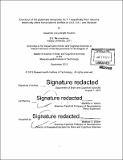Knockout of the glutamate transporter GLT-1 specifically from neurons drastically alters transcriptome profiles in CA3, CA1, and Striatum
Author(s)
Houston, Alexander Cory Wright
DownloadFull printable version (8.542Mb)
Other Contributors
Massachusetts Institute of Technology. Department of Brain and Cognitive Sciences.
Advisor
Matthew A. Wilson.
Terms of use
Metadata
Show full item recordAbstract
Precise regulation of glutamate homeostasis is critical for normal brain function, as its disruption can impair excitatory transmission and result in neurodegenerative and neuropsychiatric disorders. Critical to maintaining glutamate homeostasis is a family of sodium-dependent glutamate transporters. GLT-1, the major glutamate transporter, is responsible for >90% of brain glutamate uptake. While previously thought to exist solely on astrocytes, the Rosenberg lab has identified GLT-1 as the major, if not only, glutamate transporter associated with excitatory terminals, particularly in CA3 pyramidal neuron axon terminals within CA3 and CA1 as well as in cortical layer V pyramidal neuron axon terminals within striatum. The specific functions of GLT-1 in axon terminals in regulating glutamate homeostasis and synaptic transmission are unknown; in order to investigate these functions, the Rosenberg lab has generated a conditional GLT- 1 KO mouse line where GLT-1 can be specifically deleted from neurons. The aim of this project was to investigate the transcriptome profiles resultant from knockout of neuronal GLT-1 (nGLT-1), within regions known to express GLT-1 on neurons, and to identify and characterize alterations in known biological pathways. I report that deletion of nGLT-1 results in a high degree of differential gene expression within CA3 (1509), CAl (322), and Striatum (1268). Furthermore, these alterations in gene expression were enriched in annotated biological pathways related to energy metabolism and neurotransmission. These findings challenge the long-held assumption that, because GLT-1 expression on neurons is significantly lower than on astrocytes, nGLT-1 contributes little to the regulation of synaptic glutamate homeostasis.
Description
Thesis: S.M., Massachusetts Institute of Technology, Department of Brain and Cognitive Sciences, 2015. Cataloged from PDF version of thesis. Includes bibliographical references (pages 66-75).
Date issued
2015Department
Massachusetts Institute of Technology. Department of Brain and Cognitive SciencesPublisher
Massachusetts Institute of Technology
Keywords
Brain and Cognitive Sciences.